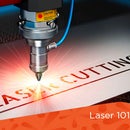Introduction: Inkscape 101
This instructable was prepared and designed for a Makerspace Meetup to introduce participants to Inkscape, a free graphics vector software that we utilize for laser cutter design.
*Updated 12.28.20 with Inkscape 1.0 version*
Step 1: Intro to Inkscape
Inkscape is a free and open source vector graphics editor. This software can be used to draw, design, and edit graphics for illustration, graphic design and in this particular event- design a file specifically for the laser.
It is compatible with PC, Mac, and Linux. It is an open sourced software, which means it is updated, enhanced, and inspected by the contributors.
You can download a free copy of Inkscape here.
Step 2: How Do We Use Inkscape?
We use it to design files for the laser cutter or any program that can read and understand layers for cutting and engraving or marking.
Patrons can design and prepare a file on Inkscape to use with other tools in our space such as the Cricut Maker, a smart cutting machine.
For this particular class, I am discussing Inkscape primarily to design and prep for the laser cutter. This class will empower you to learn the skills you need to come prepared for a laser cut appointment.
Step 3: Document Set Up
Open Inkscape and let's start setting up your document!
The default canvas is an A4 document size, we will change this to prep for the laser.
1. Go over to File - Document Properties (1st image)
2. The Document Properties window will appear, let's go over the highlighted (2nd image)
- Display Units: set this to inches or your preferred metric.
- Under Custom Size: Also, change the units to inches
- Change the Width and Height to the size of the bed
3. I have set my document size to 20" x 12" (3rd photo).
I have created templates designed for our laser cutters. These templates are based on the maximum size of the honeycomb bed that lays inside and holds the material you will be using for laser cutting and/or engraving.
This template does NOT include the material size, you will need to add that when you are ready and have measured the size of material.
Please feel free to save and use these templates as a starter.
Step 4: Layers Are Your Friend
Layers are a terrific way to distinguish levels at which you can place an object, image, or path. With layers you can stack, merge, or define layers.
It is particularly important to use layers, especially when you have several jobs to do on the laser and can choose which ones to do and which ones to hide.
- At the top, look for the Layers tab -> Layers to open the layers box
Step 5: Layers Panel
Let's look at some of the options on the Layers panel.
Plus & Minus
The + is to add a new layer (1st image).
A new dialog will appear, Add Layer
You can define that layer with a name so you know what that layer is about.
The - is to delete the selected layer you have highlighted (2nd image).
Go ahead and add the following layers (3rd image).
1. Vector
Whatever will be cut will live in that layer.
2. Raster
Whatever will be engraved will live in that layer.
3. Material
This is our material reference layer.
Open Eye & Closed Eye
The next options are what I call the Eyeball (4th image).
If you click on the eyeball that layer hides whatever designs, objects, or paths you've placed inside it. (5th image)
You can see my Vector layer has an open eye - my Raster layer has a closed eye so it's hidden.
Layer Locks
Next to the eyeball is a Lock (6th image).
The Raster layer has the lock open- which means I can move whatever is in that layer anywhere on the canvas.
The Material layer has the lock closed, meaning I can't move those objects, shapes, paths, etc. They are locked in place. This is helpful to use when you still need to move objects around that space but don't want to interfere with accidentally moving anything from other layers.
**Remember:**
Whatever you want cut, place those objects, shapes, path, etc. in the Vector layer.
Whatever you want engraved, place those objects, shapes, path, etc. in the Raster layer.
The Material layer is a reference of the material size for your laser job ensuring it all fits!
It may take some time to get use to but it definitely helps understand how layers work for laser jobs.
Step 6: Shapes
On the left-hand panel there are a few icons, let's look at what's highlighted (1st image).
The highlighted icons on the panel are
- Square
- Circle
- Polygon
The example for this project is a 5" x 5" square coaster.
1. Click on the Materials layer.
2. Then choose the square shape tool.
3. Set the width and height based on your material (2nd image).
Now, that we have the outline of our material Lock your Materials layer (3rd image).
This layer will simply serve the purpose of an outline for you to know where your design fits in the material compared to the laser bed canvas.
Step 7: Fill & Stroke
Let's go to our Vector layer.
I want to create a circle the will fit inside my Materials layer.
This circle will be the coaster cut that I want from the 5"x 5" plywood scrap.
- Click on the Vector layer, this is where your circle cut will live.
- Click on the circle shape on the left-hand panel (1st image).
Stretch your mouse and create a symmetrical circle.
Your circle will be filled with a color, but this is NOT what we want.
We only want the outline stroke of the circle and we want to designate a color defining it to be a cut.
Fill
On the right side panel - there is a dialog box called Fill and Stroke.
Let's go over Fill option
Currently, the circle is filled, we know this because there is an icon of a filled box and the RGB spectrum is active. You can move the arrows around to create whatever color you wish. (2nd image).
- Click on the X to remove the paint filled inside the shape (3rd image).
Don't worry, your circle is still there. We will now give it an outline stroke.
Stroke Paint
Move over to the Stroke Paint option
Currently, there's an invisible circle, we know this because the X icon is highlighted. This indicates there is no outline stroke defining the circle (4th image).
- Click on the filled box icon, the circle is now black.
- Change the RGB color scale to red, this is the color code for cut (5th image).
Circle on Material
Now that you've created your coaster cut outline, adjust the circle so it fits inside the material shape.
- Lock the Vector layer (6th image)
Step 8: Image Search
Great! Now we can do animage search for our coaster to engrave
- Google search a black and white image of whatever you wish to engrave.
In this example, I searched "Adventure quotes in black and white" (1st image)
1. Copy/save the image on your desktop.
2. On Inkscape,click on your Raster layer
3. Paste or drag the image onto Inkscape (2nd image)
Step 9: Trace Bitmap
Trace Bitmap Image
Trace Bitmap Image is an awesome tool to trace and give a clean image on your laser file.
1. Click on the image so the shape is outlined.
2. Right click on the image.
3. A dialog box will appear, click on Trace Bitmap (1st image).
Trace Bitmap Dialog
A pop up Trace Bitmap Dialog will open giving you options on tracing (2nd image).
There is a drop-down menu that is automatically set to Brightness Cutoff, this mode traces by brightness level and it is the one often used to clean up images.
Brightness Threshold is what you will play around with to get the best clean image giving you more black or more white depending on the threshold count.
For any and all changes you make you can preview by clicking the Update tab.
Once you are satisfied with the clean up click OK (3rd image)
Image Trace Complete
It might seem like nothing happened, but you have created a cleaner copy of the image.
- Drag the trace OUT of the original image (4th image).
You can see that I have removed the watermark that originally came with the copied image and the lines are dark and clean.
- Delete the original/copied image on Inkscape
Step 10: Bring It All Together
Alright, I know that's a lot of ground to cover but we are almost done!
This is where we can put all the elements together and see how it will turn out on the laser.
Resize Design
On ourRaster layer, let's resize our design so it fits within the red circle we created on the Vector layer.
**The only unlocked layer should be the Raster Engrave layer**
When you click on the image, you will see arrows at the corners
- Click one of the corners with your mouse and using the shortcut SHIFT + CTRL resize it inside the circle (1st image).
Attachments
Step 11: Saving for Laser Cuts
Most importantly, save your work for the laser appointment.
1st image.
- Go to File
- Save As
2nd image
- Name your work
- Save as type: SVG
- Ok
I recommend saving your work on a USB.
Step 12: Thank You!
Thank you for checking out this Instructable!
Feel free to use all the examples and files on here for practice!












